OB & Leadership: Analysis of Leadership and Organizational Behavior
VerifiedAdded on 2021/11/20
|7
|1422
|199
Report
AI Summary
This report delves into the intricacies of organizational behavior and leadership, examining the characteristics of effective leaders and the impact of leadership on employee motivation and organizational success. The report analyzes the importance of communication, vision, and planning in fostering a positive work environment. It explores organizational structures, using the Boeing Dreamliner project as a case study, and discusses the merits of tiered outsourcing and the need for adaptation during production phases. The report also focuses on employee satisfaction and motivation issues within DrainFlow, addressing job design, incentives, and recruitment processes. It recommends solutions such as improved job structures, performance-based incentives, and structured interview processes to enhance employee engagement and overall organizational performance. The report emphasizes the need for alignment between organizational perspectives and employee interests, highlighting the significance of matrix management structures for achieving maximum efficiency.
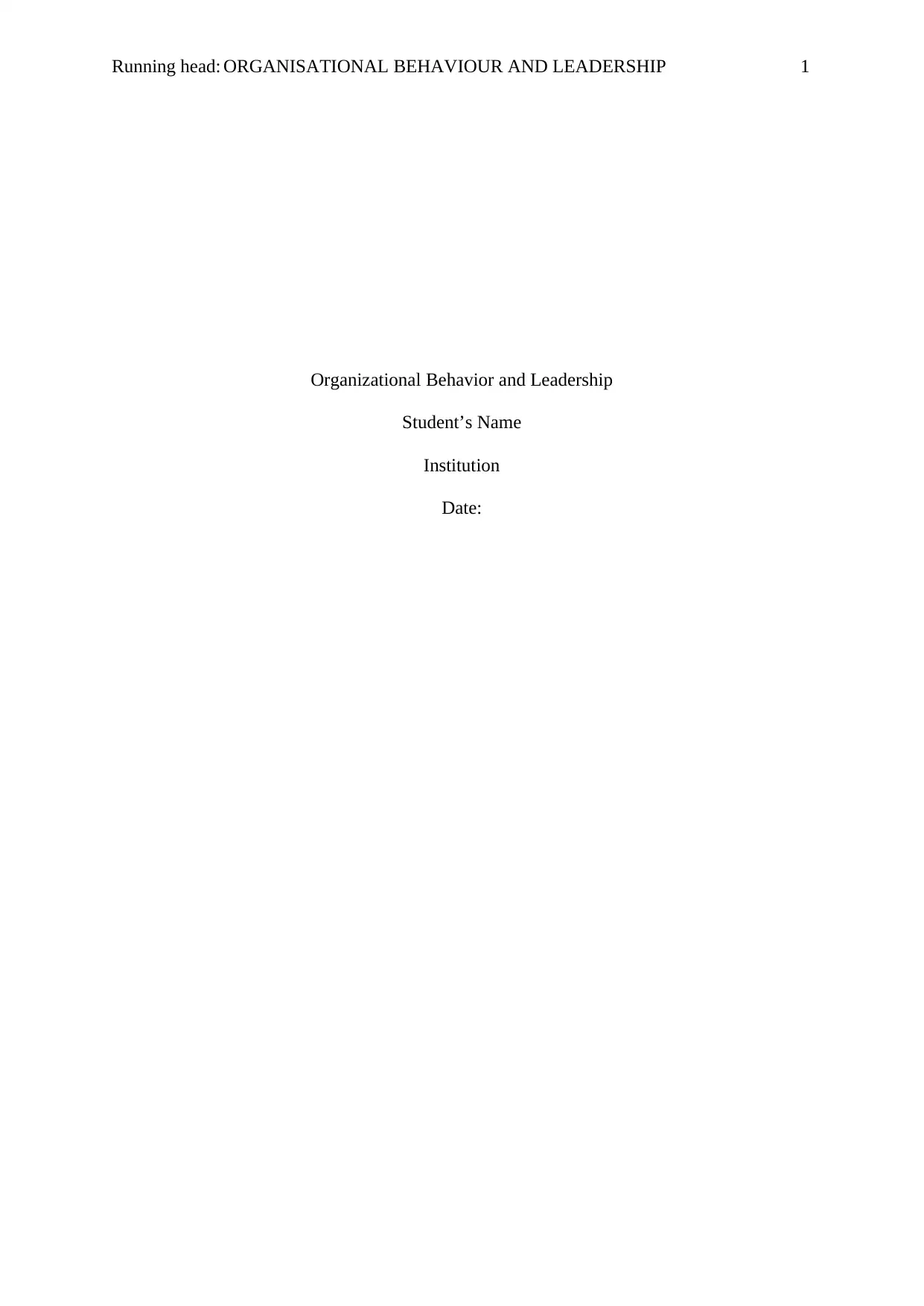
Running head: ORGANISATIONAL BEHAVIOUR AND LEADERSHIP 1
Organizational Behavior and Leadership
Student’s Name
Institution
Date:
Organizational Behavior and Leadership
Student’s Name
Institution
Date:
Paraphrase This Document
Need a fresh take? Get an instant paraphrase of this document with our AI Paraphraser
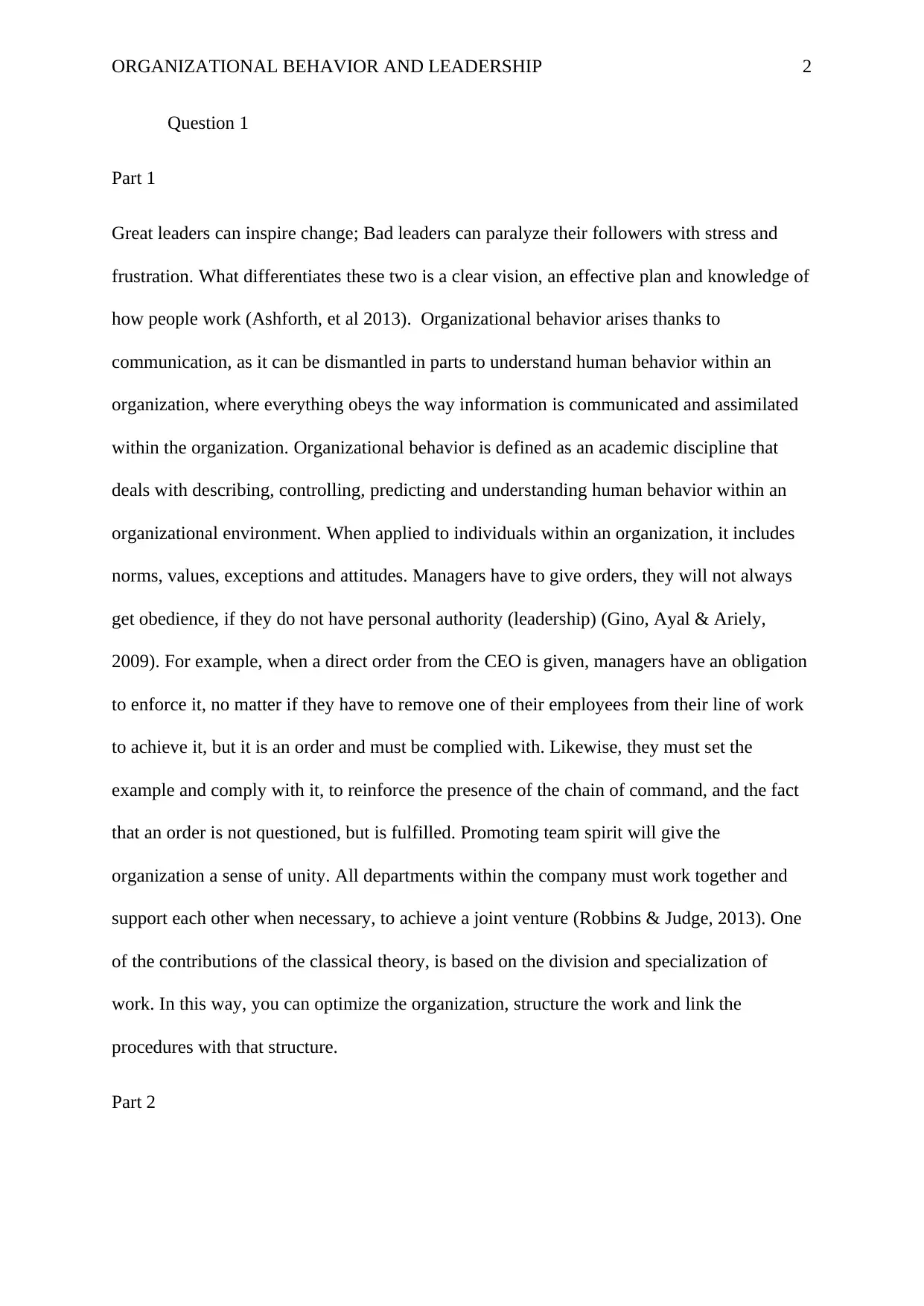
ORGANIZATIONAL BEHAVIOR AND LEADERSHIP 2
Question 1
Part 1
Great leaders can inspire change; Bad leaders can paralyze their followers with stress and
frustration. What differentiates these two is a clear vision, an effective plan and knowledge of
how people work (Ashforth, et al 2013). Organizational behavior arises thanks to
communication, as it can be dismantled in parts to understand human behavior within an
organization, where everything obeys the way information is communicated and assimilated
within the organization. Organizational behavior is defined as an academic discipline that
deals with describing, controlling, predicting and understanding human behavior within an
organizational environment. When applied to individuals within an organization, it includes
norms, values, exceptions and attitudes. Managers have to give orders, they will not always
get obedience, if they do not have personal authority (leadership) (Gino, Ayal & Ariely,
2009). For example, when a direct order from the CEO is given, managers have an obligation
to enforce it, no matter if they have to remove one of their employees from their line of work
to achieve it, but it is an order and must be complied with. Likewise, they must set the
example and comply with it, to reinforce the presence of the chain of command, and the fact
that an order is not questioned, but is fulfilled. Promoting team spirit will give the
organization a sense of unity. All departments within the company must work together and
support each other when necessary, to achieve a joint venture (Robbins & Judge, 2013). One
of the contributions of the classical theory, is based on the division and specialization of
work. In this way, you can optimize the organization, structure the work and link the
procedures with that structure.
Part 2
Question 1
Part 1
Great leaders can inspire change; Bad leaders can paralyze their followers with stress and
frustration. What differentiates these two is a clear vision, an effective plan and knowledge of
how people work (Ashforth, et al 2013). Organizational behavior arises thanks to
communication, as it can be dismantled in parts to understand human behavior within an
organization, where everything obeys the way information is communicated and assimilated
within the organization. Organizational behavior is defined as an academic discipline that
deals with describing, controlling, predicting and understanding human behavior within an
organizational environment. When applied to individuals within an organization, it includes
norms, values, exceptions and attitudes. Managers have to give orders, they will not always
get obedience, if they do not have personal authority (leadership) (Gino, Ayal & Ariely,
2009). For example, when a direct order from the CEO is given, managers have an obligation
to enforce it, no matter if they have to remove one of their employees from their line of work
to achieve it, but it is an order and must be complied with. Likewise, they must set the
example and comply with it, to reinforce the presence of the chain of command, and the fact
that an order is not questioned, but is fulfilled. Promoting team spirit will give the
organization a sense of unity. All departments within the company must work together and
support each other when necessary, to achieve a joint venture (Robbins & Judge, 2013). One
of the contributions of the classical theory, is based on the division and specialization of
work. In this way, you can optimize the organization, structure the work and link the
procedures with that structure.
Part 2
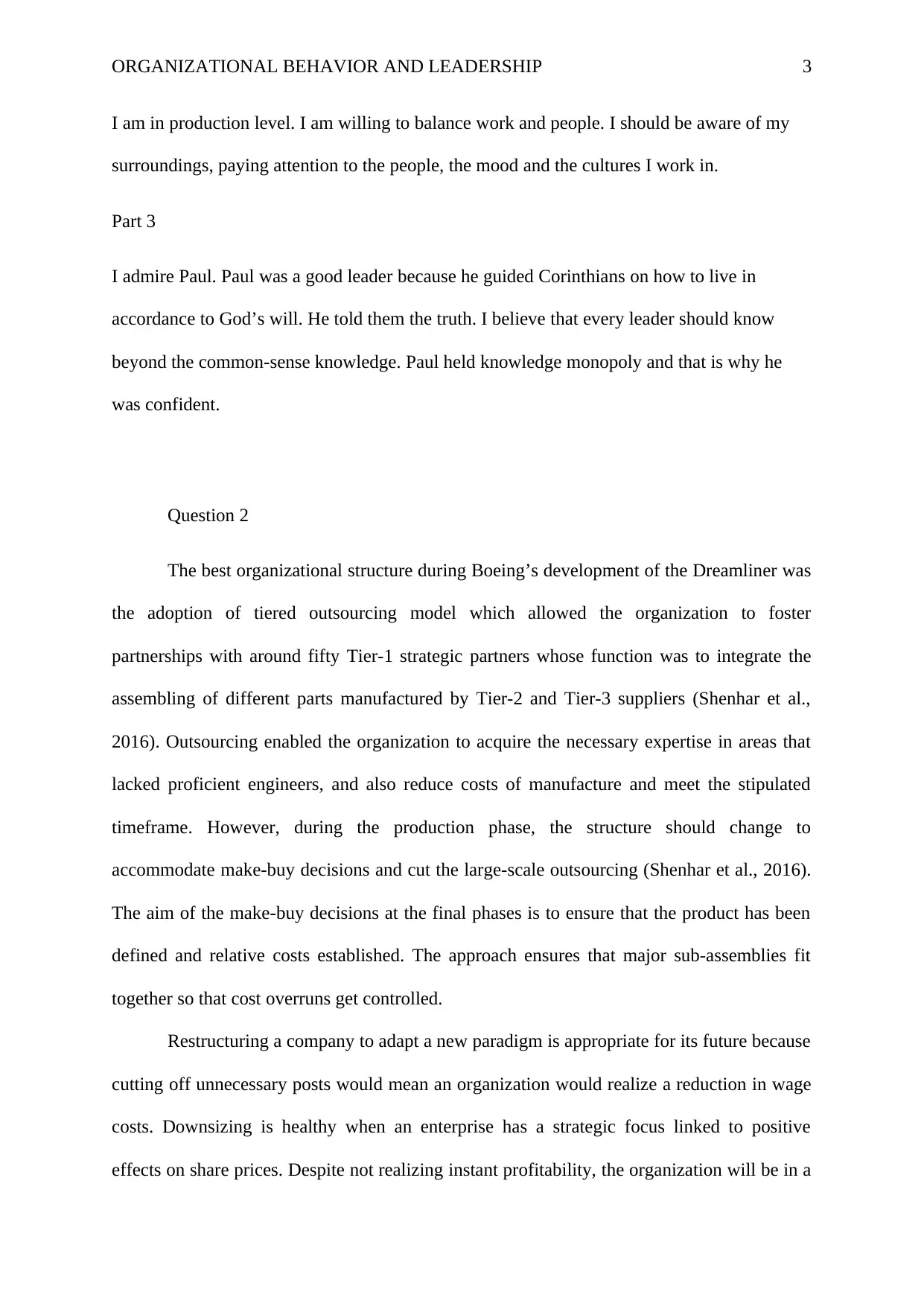
ORGANIZATIONAL BEHAVIOR AND LEADERSHIP 3
I am in production level. I am willing to balance work and people. I should be aware of my
surroundings, paying attention to the people, the mood and the cultures I work in.
Part 3
I admire Paul. Paul was a good leader because he guided Corinthians on how to live in
accordance to God’s will. He told them the truth. I believe that every leader should know
beyond the common-sense knowledge. Paul held knowledge monopoly and that is why he
was confident.
Question 2
The best organizational structure during Boeing’s development of the Dreamliner was
the adoption of tiered outsourcing model which allowed the organization to foster
partnerships with around fifty Tier-1 strategic partners whose function was to integrate the
assembling of different parts manufactured by Tier-2 and Tier-3 suppliers (Shenhar et al.,
2016). Outsourcing enabled the organization to acquire the necessary expertise in areas that
lacked proficient engineers, and also reduce costs of manufacture and meet the stipulated
timeframe. However, during the production phase, the structure should change to
accommodate make-buy decisions and cut the large-scale outsourcing (Shenhar et al., 2016).
The aim of the make-buy decisions at the final phases is to ensure that the product has been
defined and relative costs established. The approach ensures that major sub-assemblies fit
together so that cost overruns get controlled.
Restructuring a company to adapt a new paradigm is appropriate for its future because
cutting off unnecessary posts would mean an organization would realize a reduction in wage
costs. Downsizing is healthy when an enterprise has a strategic focus linked to positive
effects on share prices. Despite not realizing instant profitability, the organization will be in a
I am in production level. I am willing to balance work and people. I should be aware of my
surroundings, paying attention to the people, the mood and the cultures I work in.
Part 3
I admire Paul. Paul was a good leader because he guided Corinthians on how to live in
accordance to God’s will. He told them the truth. I believe that every leader should know
beyond the common-sense knowledge. Paul held knowledge monopoly and that is why he
was confident.
Question 2
The best organizational structure during Boeing’s development of the Dreamliner was
the adoption of tiered outsourcing model which allowed the organization to foster
partnerships with around fifty Tier-1 strategic partners whose function was to integrate the
assembling of different parts manufactured by Tier-2 and Tier-3 suppliers (Shenhar et al.,
2016). Outsourcing enabled the organization to acquire the necessary expertise in areas that
lacked proficient engineers, and also reduce costs of manufacture and meet the stipulated
timeframe. However, during the production phase, the structure should change to
accommodate make-buy decisions and cut the large-scale outsourcing (Shenhar et al., 2016).
The aim of the make-buy decisions at the final phases is to ensure that the product has been
defined and relative costs established. The approach ensures that major sub-assemblies fit
together so that cost overruns get controlled.
Restructuring a company to adapt a new paradigm is appropriate for its future because
cutting off unnecessary posts would mean an organization would realize a reduction in wage
costs. Downsizing is healthy when an enterprise has a strategic focus linked to positive
effects on share prices. Despite not realizing instant profitability, the organization will be in a
⊘ This is a preview!⊘
Do you want full access?
Subscribe today to unlock all pages.

Trusted by 1+ million students worldwide
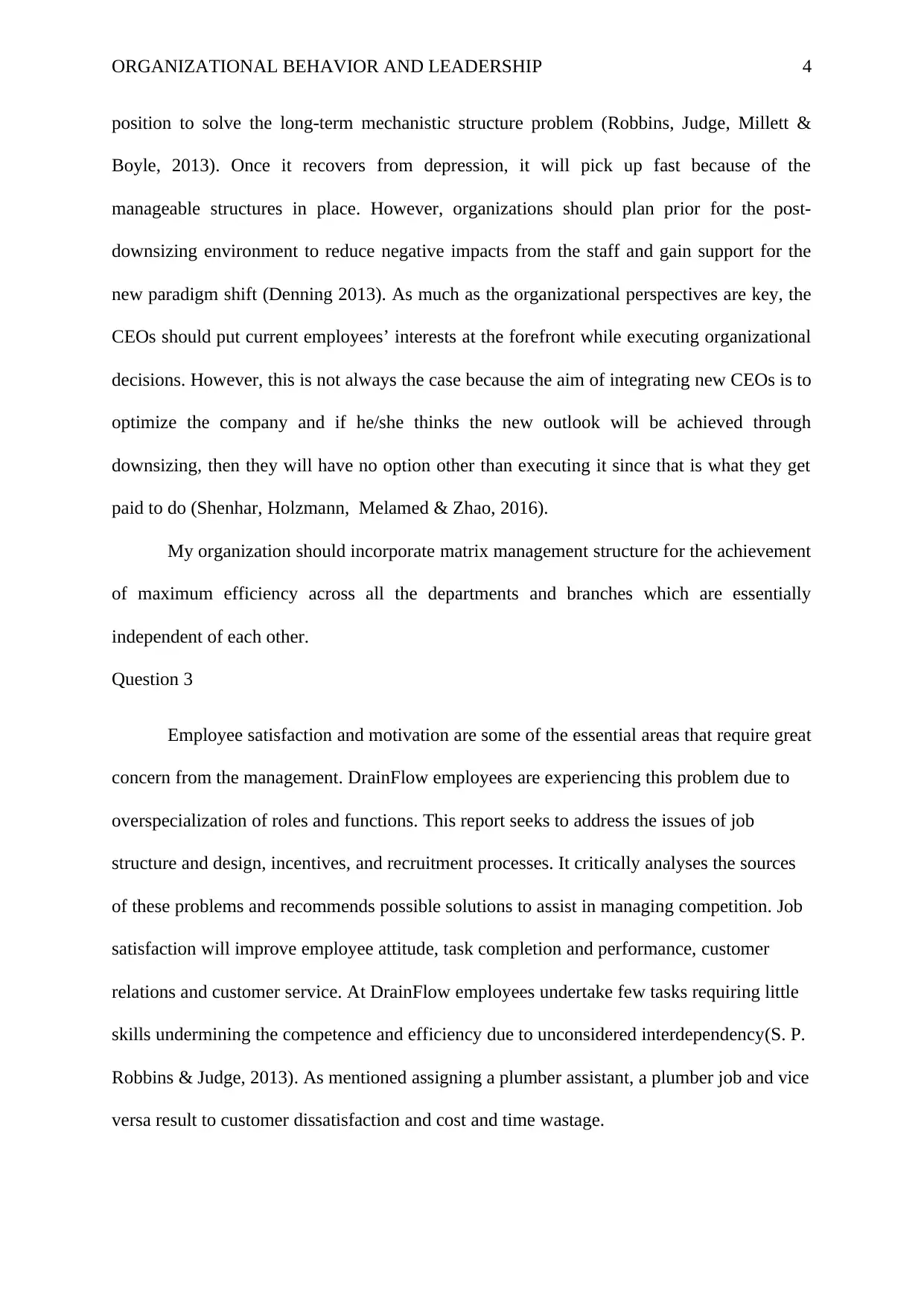
ORGANIZATIONAL BEHAVIOR AND LEADERSHIP 4
position to solve the long-term mechanistic structure problem (Robbins, Judge, Millett &
Boyle, 2013). Once it recovers from depression, it will pick up fast because of the
manageable structures in place. However, organizations should plan prior for the post-
downsizing environment to reduce negative impacts from the staff and gain support for the
new paradigm shift (Denning 2013). As much as the organizational perspectives are key, the
CEOs should put current employees’ interests at the forefront while executing organizational
decisions. However, this is not always the case because the aim of integrating new CEOs is to
optimize the company and if he/she thinks the new outlook will be achieved through
downsizing, then they will have no option other than executing it since that is what they get
paid to do (Shenhar, Holzmann, Melamed & Zhao, 2016).
My organization should incorporate matrix management structure for the achievement
of maximum efficiency across all the departments and branches which are essentially
independent of each other.
Question 3
Employee satisfaction and motivation are some of the essential areas that require great
concern from the management. DrainFlow employees are experiencing this problem due to
overspecialization of roles and functions. This report seeks to address the issues of job
structure and design, incentives, and recruitment processes. It critically analyses the sources
of these problems and recommends possible solutions to assist in managing competition. Job
satisfaction will improve employee attitude, task completion and performance, customer
relations and customer service. At DrainFlow employees undertake few tasks requiring little
skills undermining the competence and efficiency due to unconsidered interdependency(S. P.
Robbins & Judge, 2013). As mentioned assigning a plumber assistant, a plumber job and vice
versa result to customer dissatisfaction and cost and time wastage.
position to solve the long-term mechanistic structure problem (Robbins, Judge, Millett &
Boyle, 2013). Once it recovers from depression, it will pick up fast because of the
manageable structures in place. However, organizations should plan prior for the post-
downsizing environment to reduce negative impacts from the staff and gain support for the
new paradigm shift (Denning 2013). As much as the organizational perspectives are key, the
CEOs should put current employees’ interests at the forefront while executing organizational
decisions. However, this is not always the case because the aim of integrating new CEOs is to
optimize the company and if he/she thinks the new outlook will be achieved through
downsizing, then they will have no option other than executing it since that is what they get
paid to do (Shenhar, Holzmann, Melamed & Zhao, 2016).
My organization should incorporate matrix management structure for the achievement
of maximum efficiency across all the departments and branches which are essentially
independent of each other.
Question 3
Employee satisfaction and motivation are some of the essential areas that require great
concern from the management. DrainFlow employees are experiencing this problem due to
overspecialization of roles and functions. This report seeks to address the issues of job
structure and design, incentives, and recruitment processes. It critically analyses the sources
of these problems and recommends possible solutions to assist in managing competition. Job
satisfaction will improve employee attitude, task completion and performance, customer
relations and customer service. At DrainFlow employees undertake few tasks requiring little
skills undermining the competence and efficiency due to unconsidered interdependency(S. P.
Robbins & Judge, 2013). As mentioned assigning a plumber assistant, a plumber job and vice
versa result to customer dissatisfaction and cost and time wastage.
Paraphrase This Document
Need a fresh take? Get an instant paraphrase of this document with our AI Paraphraser
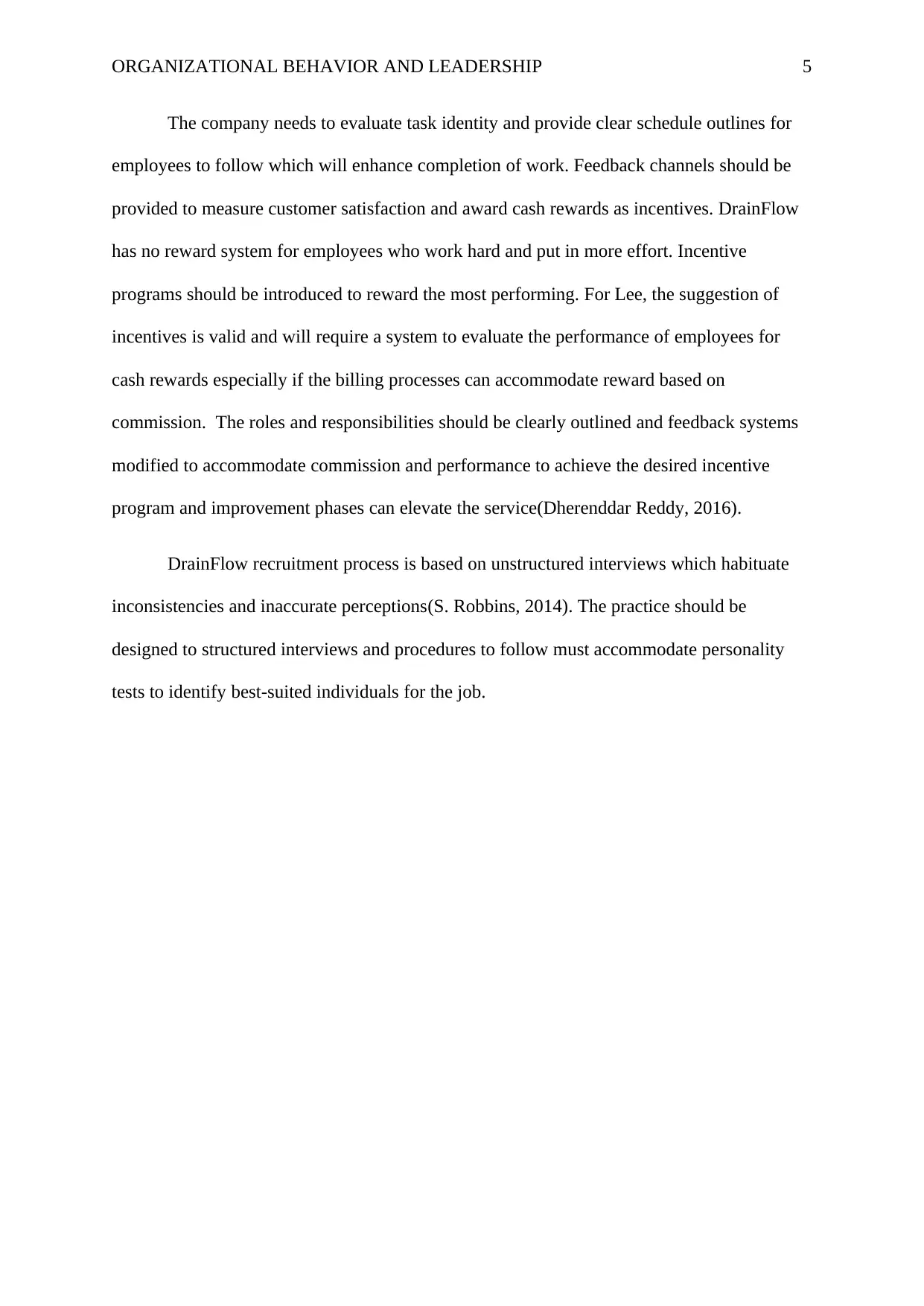
ORGANIZATIONAL BEHAVIOR AND LEADERSHIP 5
The company needs to evaluate task identity and provide clear schedule outlines for
employees to follow which will enhance completion of work. Feedback channels should be
provided to measure customer satisfaction and award cash rewards as incentives. DrainFlow
has no reward system for employees who work hard and put in more effort. Incentive
programs should be introduced to reward the most performing. For Lee, the suggestion of
incentives is valid and will require a system to evaluate the performance of employees for
cash rewards especially if the billing processes can accommodate reward based on
commission. The roles and responsibilities should be clearly outlined and feedback systems
modified to accommodate commission and performance to achieve the desired incentive
program and improvement phases can elevate the service(Dherenddar Reddy, 2016).
DrainFlow recruitment process is based on unstructured interviews which habituate
inconsistencies and inaccurate perceptions(S. Robbins, 2014). The practice should be
designed to structured interviews and procedures to follow must accommodate personality
tests to identify best-suited individuals for the job.
The company needs to evaluate task identity and provide clear schedule outlines for
employees to follow which will enhance completion of work. Feedback channels should be
provided to measure customer satisfaction and award cash rewards as incentives. DrainFlow
has no reward system for employees who work hard and put in more effort. Incentive
programs should be introduced to reward the most performing. For Lee, the suggestion of
incentives is valid and will require a system to evaluate the performance of employees for
cash rewards especially if the billing processes can accommodate reward based on
commission. The roles and responsibilities should be clearly outlined and feedback systems
modified to accommodate commission and performance to achieve the desired incentive
program and improvement phases can elevate the service(Dherenddar Reddy, 2016).
DrainFlow recruitment process is based on unstructured interviews which habituate
inconsistencies and inaccurate perceptions(S. Robbins, 2014). The practice should be
designed to structured interviews and procedures to follow must accommodate personality
tests to identify best-suited individuals for the job.
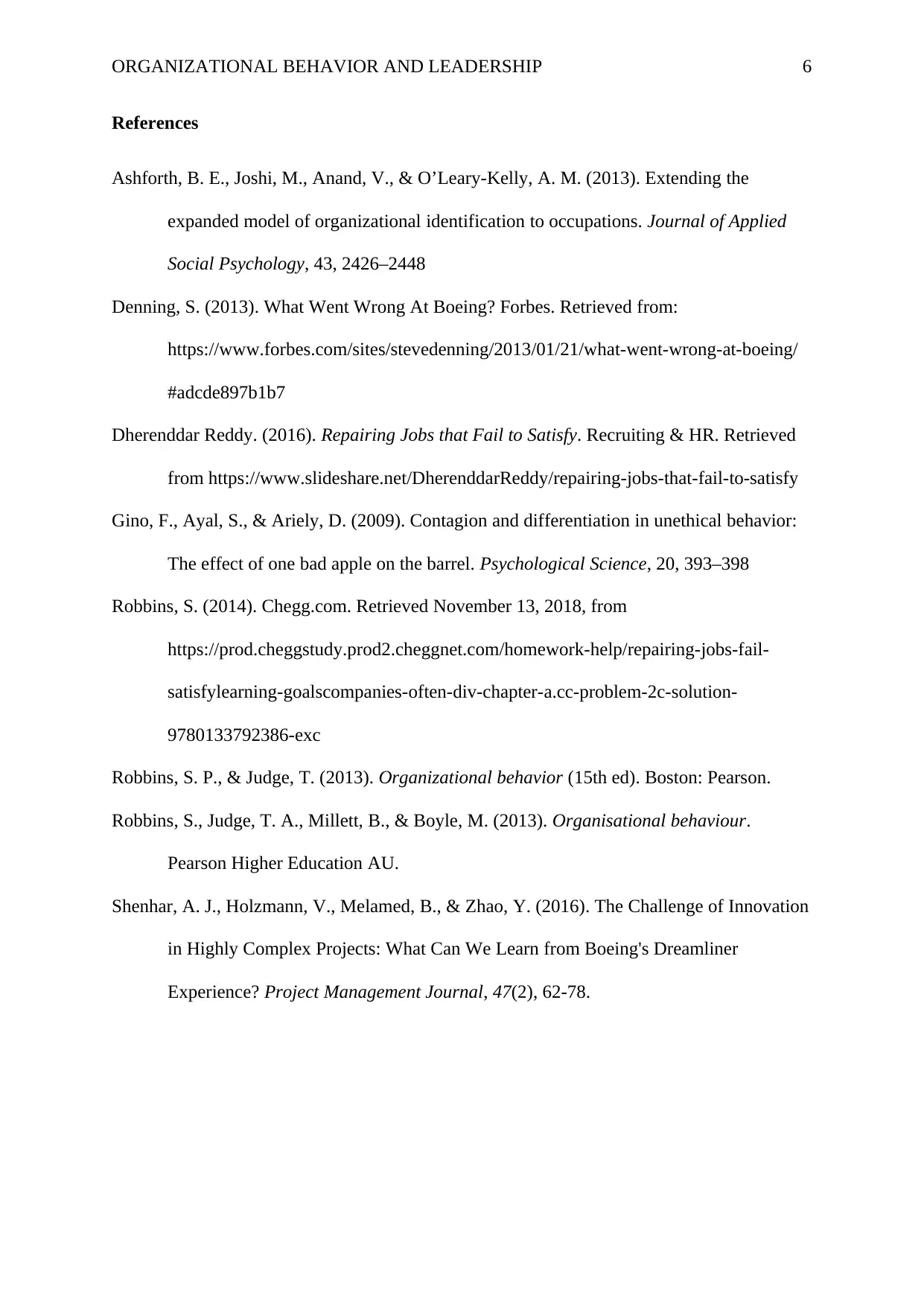
ORGANIZATIONAL BEHAVIOR AND LEADERSHIP 6
References
Ashforth, B. E., Joshi, M., Anand, V., & O’Leary-Kelly, A. M. (2013). Extending the
expanded model of organizational identification to occupations. Journal of Applied
Social Psychology, 43, 2426–2448
Denning, S. (2013). What Went Wrong At Boeing? Forbes. Retrieved from:
https://www.forbes.com/sites/stevedenning/2013/01/21/what-went-wrong-at-boeing/
#adcde897b1b7
Dherenddar Reddy. (2016). Repairing Jobs that Fail to Satisfy. Recruiting & HR. Retrieved
from https://www.slideshare.net/DherenddarReddy/repairing-jobs-that-fail-to-satisfy
Gino, F., Ayal, S., & Ariely, D. (2009). Contagion and differentiation in unethical behavior:
The effect of one bad apple on the barrel. Psychological Science, 20, 393–398
Robbins, S. (2014). Chegg.com. Retrieved November 13, 2018, from
https://prod.cheggstudy.prod2.cheggnet.com/homework-help/repairing-jobs-fail-
satisfylearning-goalscompanies-often-div-chapter-a.cc-problem-2c-solution-
9780133792386-exc
Robbins, S. P., & Judge, T. (2013). Organizational behavior (15th ed). Boston: Pearson.
Robbins, S., Judge, T. A., Millett, B., & Boyle, M. (2013). Organisational behaviour.
Pearson Higher Education AU.
Shenhar, A. J., Holzmann, V., Melamed, B., & Zhao, Y. (2016). The Challenge of Innovation
in Highly Complex Projects: What Can We Learn from Boeing's Dreamliner
Experience? Project Management Journal, 47(2), 62-78.
References
Ashforth, B. E., Joshi, M., Anand, V., & O’Leary-Kelly, A. M. (2013). Extending the
expanded model of organizational identification to occupations. Journal of Applied
Social Psychology, 43, 2426–2448
Denning, S. (2013). What Went Wrong At Boeing? Forbes. Retrieved from:
https://www.forbes.com/sites/stevedenning/2013/01/21/what-went-wrong-at-boeing/
#adcde897b1b7
Dherenddar Reddy. (2016). Repairing Jobs that Fail to Satisfy. Recruiting & HR. Retrieved
from https://www.slideshare.net/DherenddarReddy/repairing-jobs-that-fail-to-satisfy
Gino, F., Ayal, S., & Ariely, D. (2009). Contagion and differentiation in unethical behavior:
The effect of one bad apple on the barrel. Psychological Science, 20, 393–398
Robbins, S. (2014). Chegg.com. Retrieved November 13, 2018, from
https://prod.cheggstudy.prod2.cheggnet.com/homework-help/repairing-jobs-fail-
satisfylearning-goalscompanies-often-div-chapter-a.cc-problem-2c-solution-
9780133792386-exc
Robbins, S. P., & Judge, T. (2013). Organizational behavior (15th ed). Boston: Pearson.
Robbins, S., Judge, T. A., Millett, B., & Boyle, M. (2013). Organisational behaviour.
Pearson Higher Education AU.
Shenhar, A. J., Holzmann, V., Melamed, B., & Zhao, Y. (2016). The Challenge of Innovation
in Highly Complex Projects: What Can We Learn from Boeing's Dreamliner
Experience? Project Management Journal, 47(2), 62-78.
⊘ This is a preview!⊘
Do you want full access?
Subscribe today to unlock all pages.

Trusted by 1+ million students worldwide
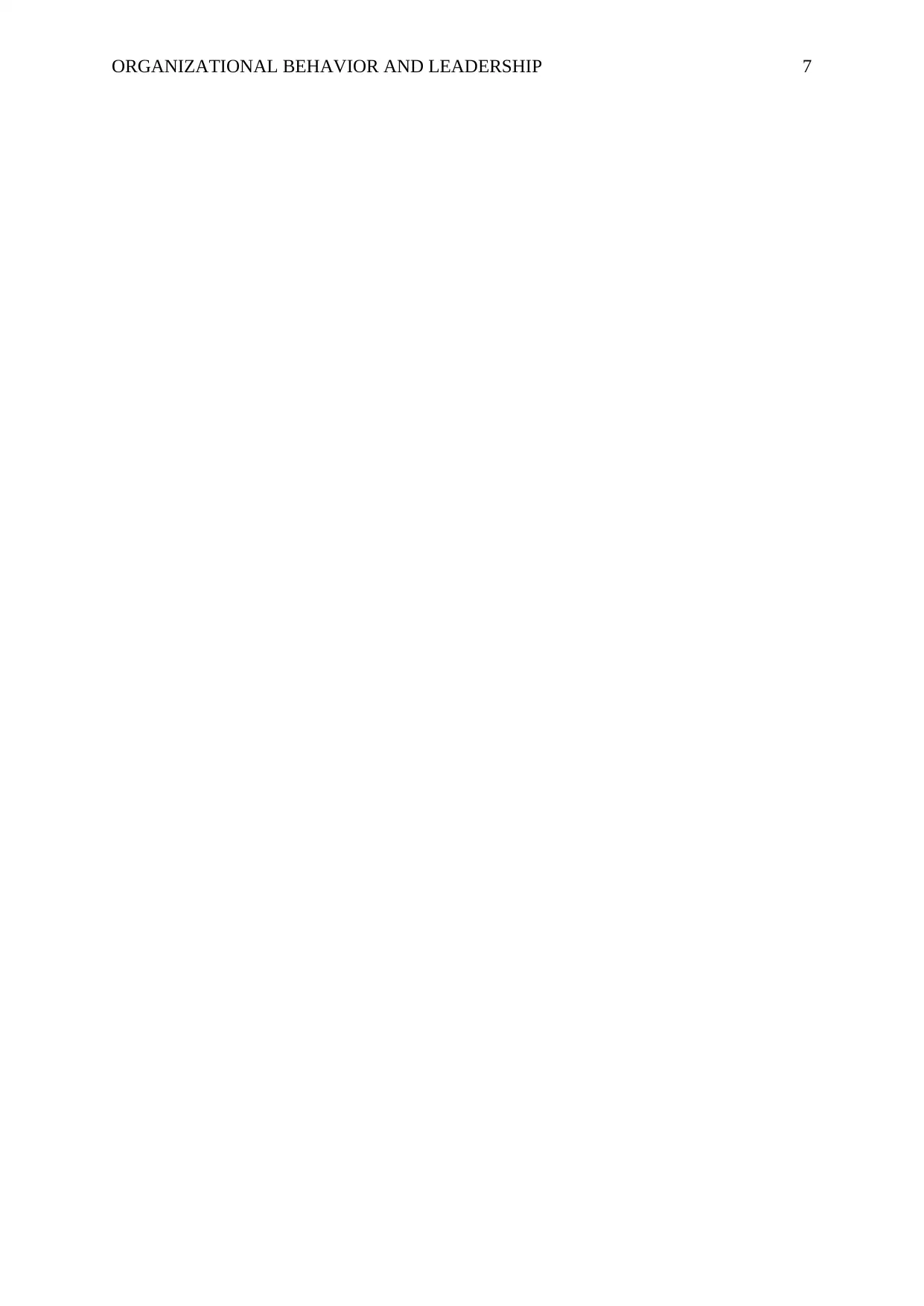
ORGANIZATIONAL BEHAVIOR AND LEADERSHIP 7
1 out of 7
Related Documents
Your All-in-One AI-Powered Toolkit for Academic Success.
+13062052269
info@desklib.com
Available 24*7 on WhatsApp / Email
![[object Object]](/_next/static/media/star-bottom.7253800d.svg)
Unlock your academic potential
Copyright © 2020–2025 A2Z Services. All Rights Reserved. Developed and managed by ZUCOL.




